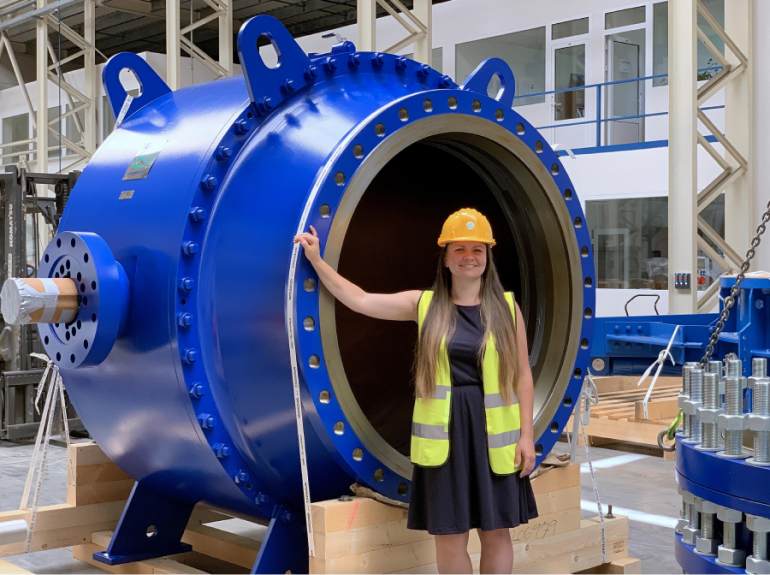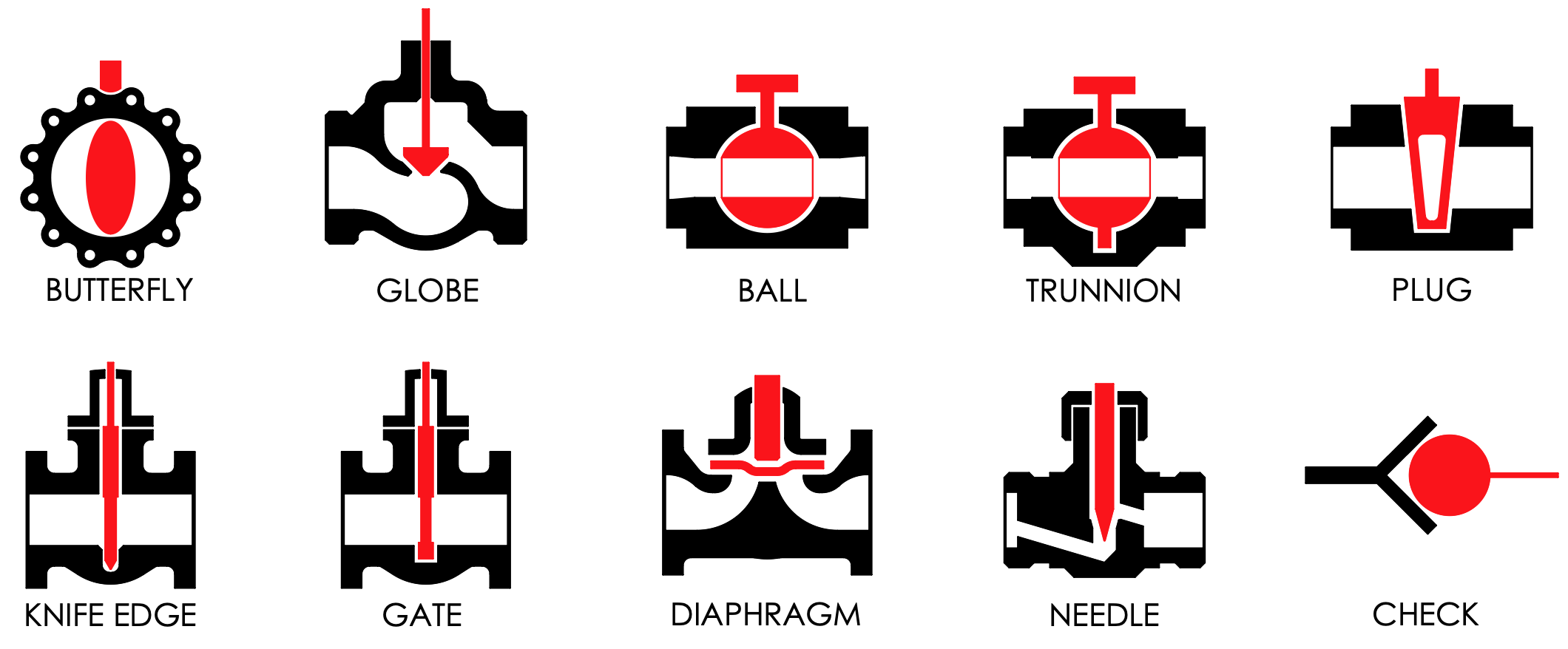A valve story is a large one. Valves are important in our daily lives without going unnoticed. There have been many articles written about valves. Here is another one, our take on valves.

Valves in piping systems come in a variety of types and are classified by their design and operational purpose. Their basic function is to regulate flow of liquid or gaseous fluids, water, air, or a mixture of sorts. Technically valves have the same basic concept using a flow controlling element inserted into the flow path inside the valve body. Valves are found in plumbing systems from large scale global projects to miniture piping lines in clinical diagnostics. A typical example of a valve is a water faucet installed in the kitchen or a bathroom sink.
Valves are categorized by their operating function, such as shut-off or flow regulation; and also by their design type such as ball valve, check valve. There are many other types and functions to list. Below is a list of a few most common valve designs.

A butterfly valve operates similar to a trunnion valve regulating large flow rates. The rotating element is in the shape of a butterfly wing, rather than a ball anchored from top and bottom. In the sense of the design a butterfly valve is a trunnion-type valve with a circular flat plate instead of a ball rotating inside the pipe. Fluid flows around the butterfly plate rather than through a hole in the center of the ball. Butterfly valves are less leak-tight than ball valves and are known for larger scale water projects and petroleum pipelines.
Globe valves are used as isolation valves, similar to gate valves, with an added function of precise flow regulation. A bonnet, or a plug in the shape of a taper is the moving element regulating the opening area between inlet and outlet ports. When fully seated the globe valve can be leak-tight in viscous fluids. If an elastomer gasket is placed atop the seating surface, the bonnet makes a leak tight seal for less viscous fluids such as water.
Ball valves are also known as floating ball valves. The name refers to a ball installed in the middle of the valve body and suspended from one end by a shaft. The ball has a through hole for letting the fluid pass from the inlet to the outlet side of the ball. Rotating the ball around its mounting axis controls the flow area. At perfect flow path alignment with the through hole, the fluid is free of any restriction. When the ball is rotated quarter-turn, 90 degrees, the flow path is closed blocking the flow. In any position between 0 and 90 degrees the ball controls the flow rate from fully-on to fully-off. Ball valves can be used for flow regulation or as shut-off valves.
The ball inside the valve housing is suspended by a shaft from the top. All load from the flow is distributed over the surface of the ball. This is a classic lever beam geometry, where the unsupported end is free to move under load. Differential pressure between the two sides of the ball creates a force displacing the ball from its rotational axis until it finds, within manufacturing tolerances, the resting place against the wall opposite from the pressure side. This creates uneven wear on the sealing surfaces limiting how much line pressure a ball valve can handle. Thus a trunnion valve was designed where the top and bottom of the ball are supported. Floating ball valves are limited by pressure rating and also by their size, where trunnion valves can be larger and can handle greater pressures.
Similar to ball valves, trunnion valves use a hollow ball as the flow regulating element. The difference between a ball vall and a trunnion valve is how the ball is mounted. The ball in trunnion valves is mounted from top and bottom with shafts on the same rotational axis, thus reinforcing against pressure. The rotating axis of the ball lies in line with the top shaft and the trunnion shaft below. Large valves also benefit from two sided mounting due to even support of ball weight.
Functionally similar to a ball valve, a plug valve has a tapered plug inserted in the flow path. Similar to a ball valve, the plug is rotated a quarter turn, 90-degrees from its full-on to full-off position. Plug valves are economical and usually used in small sized pipes. Plug valves can handle high pressure and temperatures at the same time. Tapered surface of the plug is matched to the flow cavity in the valve body with precision angle. Smooth and large surface contact between the plug and the housing provides for a leak-tight shut-off function. Plug valves are very effective in leak-tight on/off plumbing applications.
For product pass-through, gate valves are preferred choice in semiconductor equipment. The throat in the gate valve is usually of a rectangular shape where a discrete component can be moved from one chamber into another chamber joined by the valve. In large pipelines gate valves are used to control on-off flow of fluids, not super leak tight. The function of leak-tight shut-off is achieved with another valve, usually a globe valve or a trunnion valve installed in series with a gate valve. Gate valves in pipelines are used either fully open or fully closed to provide most of flow regulation without the need for high precision.
Similar to gate valves in construction, knife edge valves are typically used in slurry flow control projects. An example is a series of interconnected water ponds where knife edge valves isolate one pond from another. The word “knife” is in the valve name because the gate has a sharp edge to cut through debris in the slurry, thick mud or branches when the gate comes down to close the valve.
Needle valve derives its name from the long needle tapered on the end moving axially regulating the flow with precision. Flow area can be regulated with high precision due to the large ratio of needle travel to flow area.
Diaphragm valves are a membrane type valves where zero leakage is required from the process side to the ambient. Diaphragm completely isolates the flow area from the actuation side. On the process side the diaphragm sits on the seat when the valve is closed, and moves away from the seat to open the flow area and regulate the flow rate.
Check valves are one-way valves designed for unrestricted flow in one direction, and a leak tight seal in the opposite direction. The design of a check valve consists of a ball resting on a seat with a spring on the upstream side pressing the ball into the seal. See an example of an in-line Universal Low Pressure Check Valve with NPT Connections available from Check-All Valve Co.: Encole PN 901E120024. As an example of Ultra High Purity Check Valve with different ends, Female NPT to Male NPT Electropolished 316L VAR Stainless, see Encole PN 818E201 from GTC Products Inc.
Check valves are characterized by their cracking pressure, which is the minimum pressure at which the valve opens. Above the cracking pressure the valve is fully open allowing for free unrestricted flow. When the upstream pressure is the same as the downstream pressure for any reason, the spring forces the ball to seat preventing back-flow. In special applications the ball is not the moving element but rather a purpose specific element such as a leaf plate, having no need for a spring, or a cone-shape plug. The choice for seat materials depends on the operating temperature, chemical compatibility and leak-tight requirement. Metal-to-metal sealing is used in high purity applications or temperatures above 300C. Check valves are self-actuating from line pressure only. Check valves require no external input applied by hand or by an actuating motor.
Flow controlling elements inside a valve are actuated, turned on and off by a variety of methods including: Manually with a lever or a hand-wheel. Solenoid. Server or a stepper motor. Air-Driven. Hydraulic-Driven. Electric motor.
By their shape valves can be: in-line, tee, elbow, Y-shaped, 4-Way cross, with each end having a connection such as: